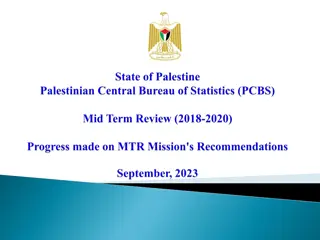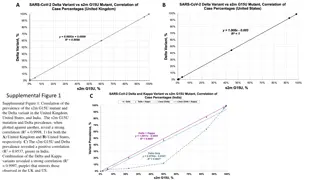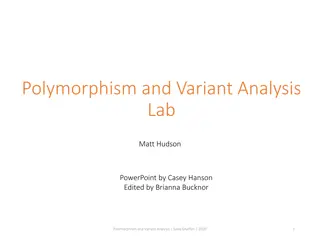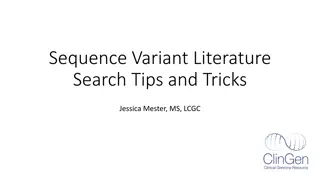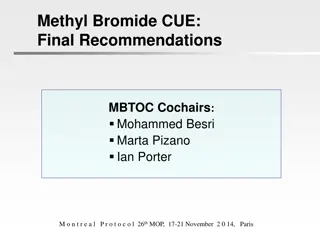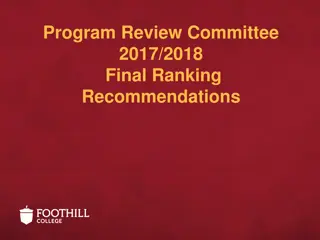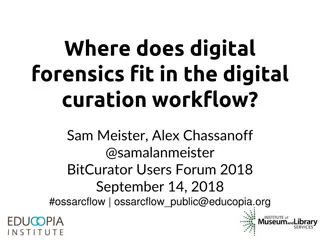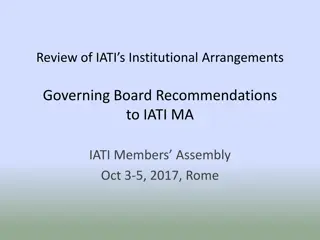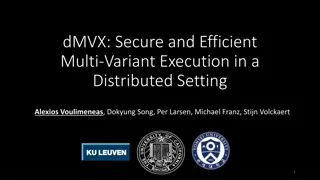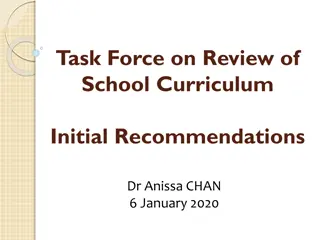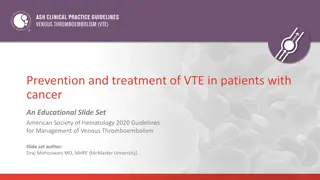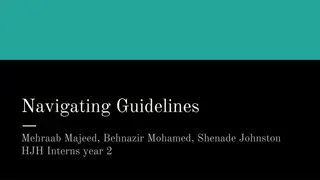BioCuration Variant Curation Guidelines and Recommendations
BioCuration Working Group's variant curation guidelines by Steven Harrison provide critical flexibility in variant classification, allowing criteria weights to be adjusted based on professional judgment. Recommendations include harmonizing ACMG/AMP guidelines and documenting strength-modified evidence using specific criteria codes. Various criteria for variant interpretation are outlined, highlighting the importance of evidence collection and genetic data evaluation.
Download Presentation

Please find below an Image/Link to download the presentation.
The content on the website is provided AS IS for your information and personal use only. It may not be sold, licensed, or shared on other websites without obtaining consent from the author.If you encounter any issues during the download, it is possible that the publisher has removed the file from their server.
You are allowed to download the files provided on this website for personal or commercial use, subject to the condition that they are used lawfully. All files are the property of their respective owners.
The content on the website is provided AS IS for your information and personal use only. It may not be sold, licensed, or shared on other websites without obtaining consent from the author.
E N D
Presentation Transcript
BioCuration WG Variant Curation Steven Harrison June 8 2017 sharrison@bwh.harvard.edu
ACMG/AMP Guidelines ClinGen Disease WGs Cardiovascular Developmental Delay Sequence Variant Interpretation WG Hereditary Cancer Harmonize recommendations for modifying ACMG guidelines Metabolism RASopathies Gene/Disease Specific ACMG Guidelines General recommendations to ACMG Guidelines
To provide critical flexibility to variant classification, some criteria listed as one weight can be moved to another weight using professional judgment, depending on the evidence collected No direction was provided regarding what criteria code to use in these instances
To document strength-modified evidence, SVI recommends using the original criteria code followed by an underscore and new level of strength Pathogenic Supporting Co-segregation with disease in multiple affected family members PP1 Moderate Strong Segregati on Data Increased segregation data
To document strength-modified evidence, SVI recommends using the original criteria code followed by an underscore and new level of strength Pathogenic Supporting Co-segregation with disease in multiple affected family members PP1 Moderate # Co-segregation with disease in multiple affected family members PP1_Moderate Strong ## Co-segregation with disease in multiple affected family members PP1_Strong Segregati on Data
Benign Pathogenic Strong Supporting Supporting Moderate Strong Very Strong MAF is too high for disorder BA1/BS1 Prevalence in affecteds statistically increased over controls (OR approach) Population Data Observation in controls inconsistent with disease penetrance BS2 Variant identified in ### probands with consistent phenotypes PS4 Variant identified in ## probands with consistent phenotypes PS4_Moderate Variant identified in # probands with consistent phenotypes PS4_Supporting Multiple lines of comp evidence suggest no impact BP4 Missense when only truncating cause disease BP1 Silent variant w/ non predicted splice impact BP7 In-frame indels in repeat w/out known function BP3 Multiple lines of computational evidence support a deleterious effect on the gene /gene product PP3 Novel missense change at an AA residue where a different pathogenic missense change has been seen before PM5 Same AA change as an established path variant PS1 Predicted null variant in a gene where LOF is a known mechanism of disease PVS1 Protein length changing variant PM4 Functional Data Well-established functional studies show no deleterious effect BS3 Missense in gene with low rate of benign missense variants and path. missenses common PP2 Mutational hot spotor well-studied functional domain PM1 Well-established functional studies show a deleterious effect PS3 Functional studies show a deleterious effect PS3_Moderate Non-segregation with disease BS4 # Co-seg w/ disease in multiple affected family members PP1 Segregation Data ## Co-seg w/ disease in multiple affected family members PP1_Moderate ### Co-seg w/ disease in multiple affected family members PP1_Strong De novo (paternity & maternity confirmed)PS2 De novo Data # De novo (without paternity & maternity confirmed) PM6_Strong De novo (without paternity & maternity confirmed) PM6 Observed in trans with a dominant variant or Observed in cis with a pathogenic variantBP2 Allelic Data For AR disorders, detected in trans with a path variant PM3 # For AR disorders, detected in trans with a path variant PM3_Strong Patient s phenotype or FH highly specific for gene PP4 # Found in case with an alternate cause BP5_Strong Found in case with an alternate cause BP5 Other Data
POPULATION DATA (BA1, BS1, BS2, PM2, PS4) Benign Pathogenic Strong Supporting Supporting Moderate Strong Very Strong MAF is too high for disorder BA1/BS1 Absent in population databases PM2 Prevalence in affecteds statistically increased over controls PS4 Observation in controls inconsistent with disease penetrance BS2
POPULATION DATA (BA1, BS1, BS2, PM2, PS4) Benign Pathogenic Strong Supporting Supporting Moderate Strong Very Strong MAF is too high for disorder BA1/BS1 Absent in population databases PM2 Prevalence in affecteds statistically increased over controls PS4 Observation in controls inconsistent with disease penetrance BS2
Proposed BA1: Allele frequency is >5% in any general continental population dataset of at least 2,000 alleles for a gene without a gene- or variant-specific recommendation
Proposed BA1: Allele frequency is >5% in any general continental population dataset of at least 2,000 alleles for a gene without a gene- or variant-specific recommendation Can compare to individual, continental populations (>2,000 alleles) Tested individual does not need to match ethnic origin of population dataset used
Proposed BA1: Allele frequency is >5% in any general continental population dataset of at least 2,000 alleles for a gene without a gene- or variant-specific recommendation
Proposed BA1: Allele frequency is >5% in any general continental population dataset of at least 2,000 alleles for a gene without a gene- or variant-specific recommendation Clinical domain working groups can define BA1 thresholds <5% (based on prevalence and penetrance) Ge ne Variant Max MAF NM_004004.5: c.109G>A (V37I) 0.072 EAS- ExAC GJB 2 Exception list for non-benign alleles >5% in continental populations NM_000410.3: c.845G>A (C282Y) 0.051 NFE- ExAC HF E NM_000060.4: c.1330G>C 0.054 FIN BT
Determine Max Credible Population AF Prevalence X Heterogeneity Penetrance BA1 (stand alone criteria for Benign) Use MOST conservative estimates BS1 (Benign strong criteria) Use less conservative estimates
Determine Max Credible Population AF BA1 Max Credible AF: 0.00487 (~0.5%) Assuming 1/40,000 prevalence 95% of Pompe due to GAA All of GAA-Pompe caused by single variant Penetrance 100%
Determine Max Credible Population AF BS1 Max Credible AF: 0.00096 (~0.1%) Assuming 1/300,000 prevalence 95% of Pompe due to GAA One GAA variant account for 50% Penetrance 85%
Great tool to help determine AF thresholds: https://cardiodb.org/allelefrequencyapp/
Filtering Allele Freq = highest AF that would be compatible with the observed allele count (95% CI Poisson)
PM2 Absent Dominant versus Recessive However, dominant does not need to be 100% absent, depending on penetrance / age of onset Hypertrophic cardiomyopathy: <0.00004 (~5 alleles max) RASopathy: strictly absent
PM2 Absent PM2 threshold could be inverse of BS1 BA1: 0.1% BS1: 0.05% PM2: <0.05% IF disorder is recessive or reduced penetrant dominant
POPULATION DATA (BA1, BS1, BS2, PM2, PS4) Benign Pathogenic Strong Supporting Supporting Moderate Strong Very Strong MAF is too high for disorder BA1/BS1 Absent in population databases PM2 Prevalence in affecteds statistically increased over controls PS4 Observation in controls inconsistent with disease penetrance BS2 Generally, should not be used based on occurrences in ExAC/gnomAD as phenotypes are unknown If disorder IS NOT penetrant at early age, consider removing this criteria Can also add occurrence thresholds RASopathy: variant identified in 3 well phenotyped individuals
POPULATION DATA (BA1, BS1, BS2, PM2, PS4) Benign Pathogenic Strong Supporting Supporting Moderate Strong Very Strong MAF is too high for disorder BA1/BS1 Absent in population databases PM2 Prevalence in affecteds statistically increased over controls PS4 Observation in controls inconsistent with disease penetrance BS2 Because the denominator for cases/probands is not always known (and thus cannot calculate an OR), guidelines state PS4 can also be used to count probands w/ consistent phenotypes
POPULATION DATA (BA1, BS1, BS2, PM2, PS4) Benign Pathogenic Strong Supporting Supporting Moderate Strong Very Strong MAF is too high for disorder BA1/BS1 Absent in population databases PM2 Prevalence in affecteds statistically increased over controls (OR method) Observation in controls inconsistent with disease penetrance BS2 Variant identified in # probands with consistent phenotypes PS4_Supporting Variant identified in ## probands with consistent phenotypes PS4_Moderate Variant identified in ### probands with consistent phenotypes PS4 PS4 could be used for typical case-control studies with an OR OR PS4 could be used for multiple unrelated probands with consistent phenotypes
Comparison of PS4 Specification PS4_Supporting PS4_Moderate PS4 (Strong) PM2 threshold <0.004% MYH7 2 probands 6 probands 15 probands RASopathy Strictly absent 1 probands 3 probands 5 probands
COMPUTATIONAL AND PREDICTIVE DATA Benign Pathogenic Strong Supporting Supporting Moderate Strong Very Strong Multiple lines of comp evidence suggest no impact BP4 Multiple lines of computational evidence support a deleterious effect on the gene /gene product PP3 Novel missense change at an AA residue where a different pathogenic missense change has been seen before PM5 Same AA change as an established path variant PS1 Predicted null variant in a gene where LOF is a known mechanism of disease PVS1 Missense when only truncating cause disease BP1 Silent variant w/ non predicted splice impact BP7 Protein length changing variant PM4 In-frame indels in repeat w/out known function BP3
COMPUTATIONAL AND PREDICTIVE DATA Benign Pathogenic Strong Supporting Supporting Moderate Strong Very Strong Multiple lines of comp evidence suggest no impact BP4 Multiple lines of computational evidence support a deleterious effect on the gene /gene product PP3 Novel missense change at an AA residue where a different pathogenic missense change has been seen before PM5 Same AA change as an established path variant PS1 Predicted null variant in a gene where LOF is a known mechanism of disease PVS1 Missense when only truncating cause disease BP1 Silent variant w/ non predicted splice impact BP7 Protein length changing variant PM4 In-frame indels in repeat w/out known function BP3 BP1 could also be used for: LOF variants in a gene where the disease: is caused by GOF variants is caused by dominant/negative LOF variants
COMPUTATIONAL AND PREDICTIVE DATA Benign Pathogenic Strong Supporting Supporting Moderate Strong Very Strong Multiple lines of comp evidence suggest no impact BP4 Multiple lines of computational evidence support a deleterious effect on the gene /gene product PP3 Novel missense change at an AA residue where a different pathogenic missense change has been seen before PM5 Same AA change as an established path variant PS1 Predicted null variant in a gene where LOF is a known mechanism of disease PVS1 Missense when only truncating cause disease BP1 Silent variant w/ non predicted splice impact BP7 Protein length changing variant PM4 In-frame indels in repeat w/out known function BP3
COMPUTATIONAL AND PREDICTIVE DATA Benign Pathogenic Strong Supporting Supporting Moderate Strong Very Strong Multiple lines of comp evidence suggest no impact BP4 Multiple lines of computational evidence support a deleterious effect on the gene /gene product PP3 Missense change at an AA residue where a different pathogenic missense change has been seen before PM5 Same AA change as an established path variant PS1 Predicted null variant in a gene where LOF is a known mechanism of disease PVS1 Missense when only truncating cause disease BP1 Silent variant w/ non predicted splice impact BP7 Protein length changing variant PM4 In-frame indels in repeat w/out known function BP3
COMPUTATIONAL AND PREDICTIVE DATA Benign Pathogenic Strong Supporting Supporting Moderate Strong Very Strong Multiple lines of comp evidence suggest no impact BP4 Multiple lines of computational evidence support a deleterious effect on the gene /gene product PP3 Missense change at an AA residue where a different pathogenic missense change has been seen before PM5 Same AA change as an established path variant PS1 Predicted null variant in a gene where LOF is a known mechanism of disease PVS1 Missense when only truncating cause disease BP1 Silent variant w/ non predicted splice impact BP7 Protein length changing variant PM4 In-frame indels in repeat w/out known function BP3 General modifications for PM5 and PS1: Allow criteria to be used for analogous genes [HRAS, NRAS, KRAS] ; [MAP2K1, MAP2K2] ; [HBA1, HBA2] Assessing variant c.37G>A (p.Gly13Ser) in HRAS; variant c.38G>A (p.Gly13Asp) in KRAS is established Pathogenic Important to define mapping between genes! Does Gly13 in HRAS = Gly13 in KRAS?
COMPUTATIONAL AND PREDICTIVE DATA Benign Pathogenic Strong Supporting Supporting Moderate Strong Very Strong Multiple lines of comp evidence suggest no impact BP4 Multiple lines of computational evidence support a deleterious effect on the gene /gene product PP3 Missense change at an AA residue where a different pathogenic missense change has been seen before PM5 Predicted null variant in a gene where LOF is a known mechanism of disease PVS1 2 different missense changes at AA residue have been seen before PM5_Strong Missense when only truncating cause disease BP1 Silent variant w/ non predicted splice impact BP7 Same AA change as an established path variant PS1 In-frame indels in repeat w/out known function BP3 Protein length changing variant PM4 General modifications for PM5: Allow PM5 to be upgraded to Strong (PM5_Strong) if 2 different pathogenic missense changes at the residue have been seen before
COMPUTATIONAL AND PREDICTIVE DATA Benign Pathogenic Strong Supporting Supporting Moderate Strong Very Strong Multiple lines of comp evidence suggest no impact BP4 Multiple lines of computational evidence support a deleterious effect on the gene /gene product PP3 Missense change at an AA residue where a different pathogenic missense change has been seen before PM5 Predicted null variant in a gene where LOF is a known mechanism of disease PVS1 2 different missense changes at AA residue have been seen before PM5_Strong Missense when only truncating cause disease BP1 Silent variant w/ non predicted splice impact BP7 Same AA change as an established path variant PS1 In-frame indels in repeat w/out known function BP3 Protein length changing variant PM4 General modifications for PS1: Can also be used for splice site variants
PS1: Splice Site Variants Example: You are assessing IVS3+5G>T and IVS3+5G>A meets criteria for established pathogenic and has been showed to impact splicing in a functional assay. IVS3+5G>T has not been studied functionally but in silico splicing predictions show IVS3+5G>T is equally or more damaging than IVS3+5G>A = PS1 met If in the same scenario (with IVS3+5G>A meeting criteria for established pathogenic and has been showed to impact splicing in a functional assay) silico splicing predictions suggest IVS3+5G>T is not as damaging asIVS3+5G>A = PS1 not met If PS1 is met in these instances, PP3 (in silico prediction) would NOT be applied
COMPUTATIONAL AND PREDICTIVE DATA Benign Pathogenic Strong Supporting Supporting Moderate Strong Very Strong Multiple lines of comp evidence suggest no impact BP4 Multiple lines of computational evidence support a deleterious effect on the gene /gene product PP3 Predicted null variant in a gene with moderate level of evidence for LOF as a disease mechanism PVS1_Moderate Predicted null variant in a gene where LOF is a known mechanism of disease PVS1 Missense when only truncating cause disease BP1 Silent variant w/ non predicted splice impact BP7 Missense change at an AA residue where a different pathogenic missense change has been seen before PM5 2 different missense changes at AA residue have been seen before PM5_Strong In-frame indels in repeat w/out known function BP3 Same AA change as an established path variant PS1 Protein length changing variant PM4 General modifications for PVS1: Can be downgraded to Moderate if: LOF is not an established disease mechanism Only moderate level of evidence for gene/disease pair, but all the evidence supports LOF as the disease mechanism
DE NOVO DATA Benign Pathogenic Strong Supporting Supporting Moderate Strong Very Strong De novo (paternity & maternity confirmed) PS2 De novo (without paternity & maternity confirmed) PM6
DE NOVO DATA Example: Patient had a de novo missense variant in MECP2 but only presented with ID no Rett phenotypes
DE NOVO DATA Benign Pathogenic Strong Supporting Supporting Moderate Strong Very Strong De novo (paternity & maternity confirmed) PS2 2 De novo occurrences (paternity & maternity confirmed) PS2 2 De novo occurrences (without paternity & maternity confirmed) PM6_Strong De novo (without paternity & maternity confirmed) PM6 For PS2 and PM6, can increase strength with increasing independent de novo occurrences
ALLELIC DATA Benign Pathogenic Strong Supporting Supporting Moderate Strong Very Strong Observed in trans with a dominant variant or Observed in cis with a pathogenic variant BP2 For recessive disorders, detected in trans with a pathogenic variant PM3 For PM3, shift weight according to variant strength and number of occurrences
ALLELIC DATA Benign Pathogenic Strong Supporting Supporting Moderate Strong Very Strong Observed in trans with a dominant variant or Observed in cis with a pathogenic variant BP2 For recessive disorder, biallelic variants but variant on the other allele does not meet pathogenic criteria PM3_Supporting For recessive disorders, detected in trans with a pathogenic variant PM3 For recessive disorders, 2 occurrences when detected in trans with a pathogenic variant PM3_Strong Supporting: Variant on the other allele suspicious and absent from control dbs OR Proband homozygous for the variant and variant absent from control dbs Strong: 2 unrelated probands compound het with different pathogenic variants in trans Proband 1: p.H308fs;p.Y3955X Proband 2: p.H308fs;p.N405fs Proband 3: p.H308fs;p.N405fs
OTHER DATABASES Benign Pathogenic Strong Supporting Supporting Moderate Strong Very Strong Reputable source = benign BP6 Reputable source = pathogenic PP5
OTHER DATABASES Benign Pathogenic Strong Supporting Supporting Moderate Strong Very Strong Reputable source = benign BP6 Reputable source = pathogenic PP5 CRITERIA SHOULD NOT BE USED
Move to Bayes Approach ACMG/AMP criteria are compatible with this quantitative approach
Move to Bayes Approach Allow us to make better definitions for VUS and when Pathogenic and Benign data conflict (PVS# + PM# + PM#) + BP# = Pathogenic (PS# + PS#) + BS# = Uncertain significance


